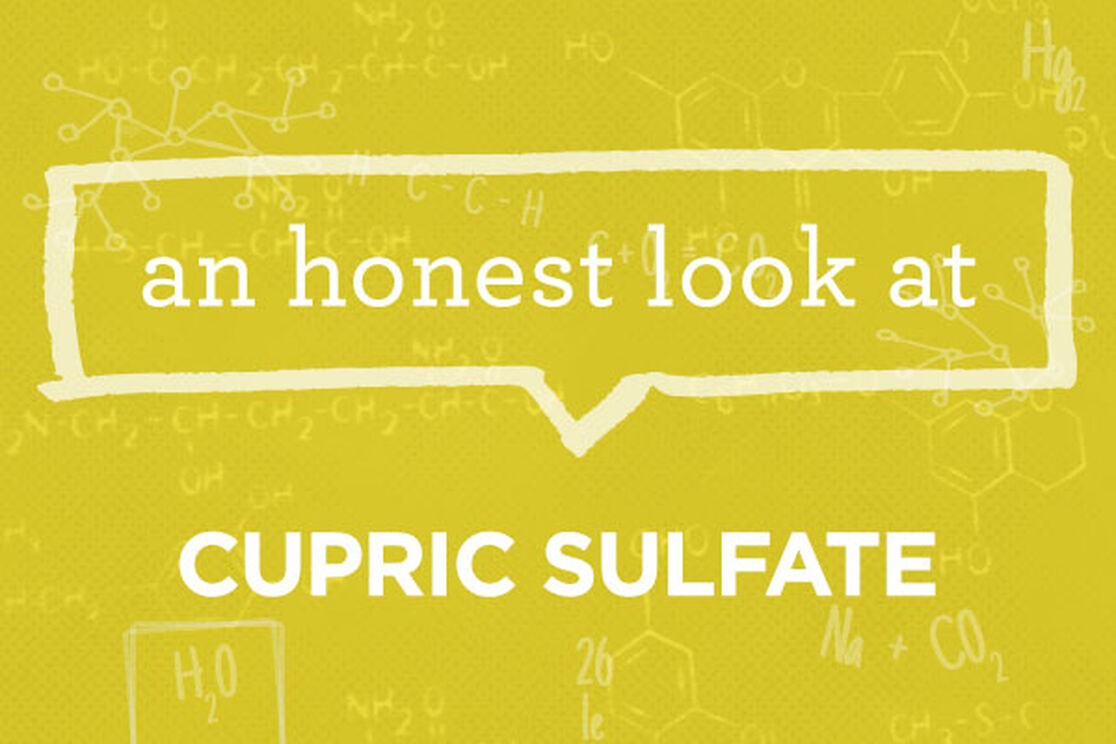This is part of our ongoing series to help consumers better understand chemicals, chemistry, and product formulations. We translate the science, bust the myths, and give you an honest assessment, so you can make informed choices for your family!
Ingredient:
Cupric sulfate (aka copper sulfate and copper sulphate)
What it is:
Copper sulfate is a salt of the mineral copper.
What it does:
Copper is a natural metal and it’s also a trace mineral that’s vital to the health of all living things (humans, animals, plants, and microorganisms). It’s found in every tissue of our bodies and stored in our livers in case of deficiency. Why do we need it?
- It works with iron to help form red blood cells (1).
- It helps support the immune system (1).
- It plays a role in creating myelin (the sheath covering nerve fibres), collagen (which helps form bones, skin, and connective tissue), and melanin (pigment that gives color to hair and skin) (1).
- Copper enzymes help regulate things like energy production and neurotransmission (1).
Dietary sources of copper include organ meats, shellfish, nuts, seeds, wheat-bran cereals, and whole-grains (1). A healthy diet easily provides all the copper needed to support health, but in some cases a supplement is necessary. The supplementary forms of copper are cupric oxide, copper gluconate, copper sulfate (cupric sulfate), and copper amino acid chelates (1).
Why we use it:
We have copper in our Organic Premium Infant Formula because it’s required by law and, more importantly, vital to infant health. We chose the cupric sulfate form because it’s more bioavailable — meaning it’s more readily available for absorption (2,3). One study found that infants absorb and retain about 75% of the copper in breast milk, but only 52% from copper-fortified formula (4). By choosing a form that’s more bioavailable, we hope to provide an infant formula that’s closer to the nutrient profile of breast milk.
Why we’re featuring it today:
If you Google “copper sulfate” you’re going to see it’s used as a pesticide — a more than worrisome finding for parents trying to better understand what’s in the formula they’re feeding their babies. We understand the concern, but — rest assured — there’s some very basic science going on here and there’s nothing to worry about.
Yes, at very high doses cupric sulfate can act as an effective, natural pesticide; and in very high doses (as with almost everything) it can be harmful to health. But the level present in infant formula is based on careful studies determining infant nutritional needs (5).
Infant formula is very strictly regulated by the FDA (Food and Drug Administration). Manufacturers can't add ingredients without following the strict guidelines of The Infant Formula Act – which includes a very precise list of what must be included and at what levels. And when any new nutrient is proposed for addition, regulators take into account everything from biology and toxicology to exposure levels and speed of metabolism and elimination. Research is done to establish at what level adverse effects are observed and then they determine allowable exposure levels by building in significant safety factors in order to err on the side of caution.
In the case of copper in infant formula, the recommended amount set by the government (200 mcg) is roughly 3,750 times less than the dose that is shown to elicit even the smallest adverse human health effect (750,000 mcg) (1, 6). And, as you can maybe guess, this level is infinitesimally less than the amount of copper sulphate used as a pesticide.
Copper sulfate supplements are in the microgram range while pesticide applications are in pounds. What this means is pesticide applications are about a billion times greater than what’s used in infant formula and supplements. And we may toss around the word “billion” like it’s no big deal, but it’s a HUGE number. Consider this: one billion seconds is 31 ½ years. Translate that to our product vs. pesticide issue and you have copper sulfate equalling a few seconds and pesticide applications equalling over 30 years. Put another way: if the product volume was a grain of sugar, the pesticide volume would be an entire car filled to the brim with sugar. The difference is barely fathomable.
All in all, it's a perfect example of the fundamental tenet of toxicology: the dose makes the poison. Everything, even water, can be toxic at some level. We’ve done enormous amounts of research to ensure our formula is safe and nutritious because it’s exactly what we want for our own babies!
References:
- Linus Pauling Institute Micronutrient Research for Optimum Health. (n.d.). Retrieved March 24, 2015, from http://lpi.oregonstate.edu/infocenter/minerals/copper/
- Johnson, M. A., Smith, M. M., & Edmonds, J. T. (1998). Copper, iron, zinc, and manganese in dietary supplements, infant formulas, and ready-to-eat breakfast cereals. The American journal of clinical nutrition, 67(5), 1035S-1040S.
- Wapnir, R. A. (1998). Copper absorption and bioavailability. The American journal of clinical nutrition, 67(5), 1054S-1060S.
- Lönnerdal, B. (1998). Copper nutrition during infancy and childhood. The American journal of clinical nutrition, 67(5), 1046S-1053S.
- Food and Nutrition Board, Institute of Medicine. Copper. Dietary reference intakes for vitamin A, vitamin K, boron, chromium, copper, iodine, iron, manganese, molybdenum, nickel, silicon, vanadium, and zinc. Washington, D.C.: National Academy Press; 2001:224-257.
- Copper Sulfate. (n.d.). Retrieved March 24, 2015, from http://pmep.cce.cornell.edu/profiles/extoxnet/carbaryl-dicrotophos/copper-sulfate-ext.html
We aim to provide you with the most honest and credible information possible. This article was reviewed for accuracy by The Honest Team and was written based on sources that are linked at the bottom of the article.
blog_review_statement



